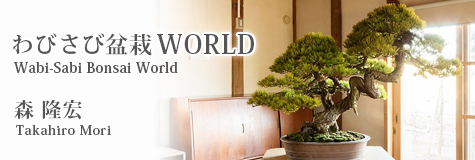
Vol. 8 The Joys of Viewing Bonsai in Autumn
In late September, bonsai aficionados begin preparing the bonsai trees they have been raising lovingly for their moment in the sun at the autumn exhibits. They spare no effort, trimming back overly spindly branches and supporting irregular branches with wires in anticipation of the valuable opportunity to display their trees to the local community and other aficionados.
All sorts of bonsai are displayed at these exhibits, from the standard conifers to deciduous trees in autumn colors, and even ones bearing adorable little fruits. The struggle to decide which trees to exhibit is another source of enjoyment for the bonsai artists.
Let me take this moment to explain again the different varieties of bonsai.
Bonsai can generally be divided into three categories: shohaku, kusamono, and zoki.
Shohaku bonsai include all the evergreen conifers, such as black pine, red pine, white pine, Yezo spruce, Chinese and common juniper, yew, and cedar.
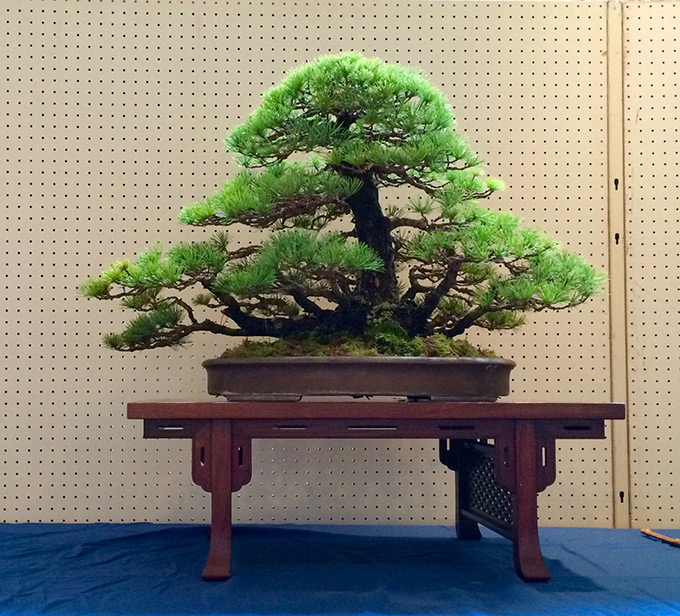
The white pine--the signature shohaku--evokes a sense of strength.
Kusamono bonsai are individual or grouped plants and flowers, and typically fill the role of accenting the centerpiece trees at showings. Yet these seasonal plants go beyond that simple role by helping to create a story for the exhibit, while attracting the eye of the observer despite their smaller size.
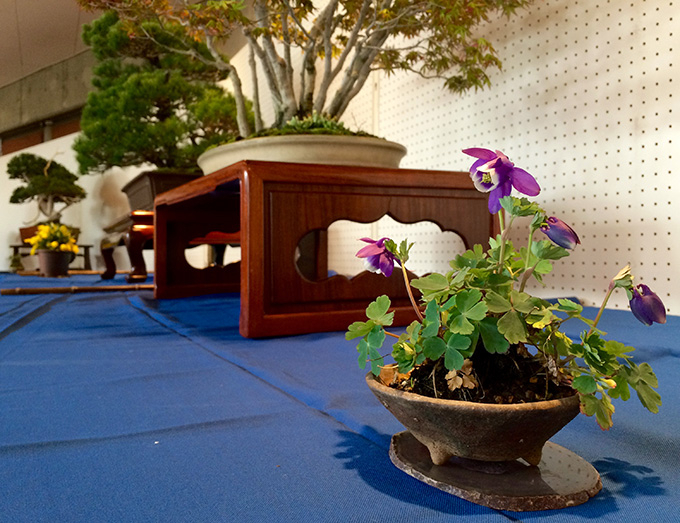
Kusamono bonsai that makes an impact despite its small size.
Zoki bonsai encompass evergreen broadleaved and deciduous broadleaved trees such as plum, camellia, maple, and quince. This category can be further broken down into mimono bonsai, hanamono (or edamono) bonsai, and hamono bonsai. Mimono bonsai are fruit-bearing trees usually displayed when laden with fruit. Examples include quince, umemodoki (Ilex serrata), Siebold's crabapple, Hamilton's spindletree, and persimmon. Hanamono bonsai are flowering trees--plum, camellia, cherry, wisteria, rose, and the like--and are normally exhibited when in bloom. Hamono (or edamono) bonsai are trees appreciated more for their leaves or branches, such as maple, zelkova, beech, and carnipus. They may be shown with their new leaves, after the leaves have turned, or even bare after the leaves have fallen.
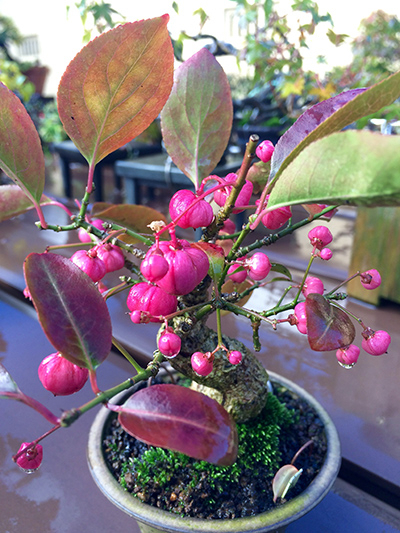
Hamilton's spindletree, categorized as a mimono, is notable for its autumn leaves and adorable fruits.
The best way to enjoy mimono bonsai is of course to view them when fruiting. To get the most out of this experience there are a few things you need to know.
First, everyone will likely remember learning about the stamen and pistil in elementary school, but were you aware that many tree species also have male and female differences? In botanical terms this is called "dioecious," meaning the male and female reproductive organs of the trees are expressed in separate individuals. Some dioecious females do not bear fruit unless placed near a male when in bloom. The Diospyros rhombifolia variety of persimmon is a leading example.
There is also the monoecious category of trees, which can self-pollinate because both male and female flowers bloom on the same plant. Examples of this type include chestnut and chocolate vine.
Recently, some bonsai sellers offer female trees that can bear fruit on their own. When making a purchase, be sure to ask whether the plant will bear fruit. Also, keep in mind that some self-pollinating trees do better when cross-pollinated, so you may need two.
For a tree to bear fruit, its flowers must first bloom. This goes without saying, because the fruit develops after the flower. Accordingly, you must be extra careful to adequately water the tree when in bloom--but you must also be sure not to wet the flowers directly.
The other important thing is sunlight. While it depends on the type of tree, the formation of flower buds typically peaks between late June and early August. If there is not enough sunlight during this period, then it will be difficult for the flower buds to form.
This is embarrassing to admit, but the plum tree at my home bore no flower buds at all this year. As a measure for increasing the number of buds, I trimmed back all new leaves that formed this year in late May, and even though the next set of leaves came in, the buds for next year's flowers did not form at all because the tree didn't get enough light. Completely ruining the chance to enjoy a once-a-year experience is pathetic for a professional.
While it was clear that the cause behind the problem with my plum tree this year was inadequate sunlight, trial and error to discover the reason why trees fail to blossom or bear fruit is an important part of taking care of bonsai in the long term. So, don't give up if you fail this year, but simply try again next year.
The most important thing you must watch out for to enjoy the autumn foliage of hamono bonsai, such as various types of maple, is to prevent parching of the leaves in summer. Many younger trees aged approximately five years since planting can easily suffer from parched leaves, but as they grow further and increase the number of roots, they become strong enough to tolerate relatively intense sunlight.
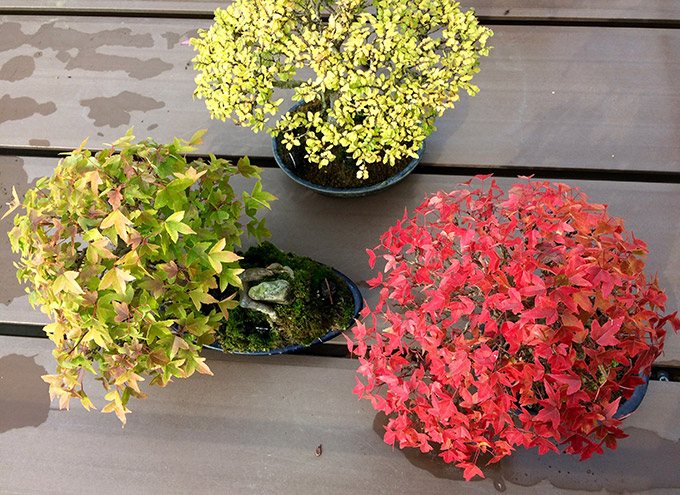
Autumn is the season to enjoy the colorful foliage of maple and nire-keyaki (Ulmus parvifolia).
Provided healthy leaves have been maintained as autumn advances, you can then prepare for the leaves to turn. The main criterion for the leaves to change color is the temperature difference between day and night. You can help create the right conditions by watering the leaves in the evening. This drops the temperature of the leaves significantly, triggering the display of vibrant autumn colors.
What could be more fashionable than achieving this fall foliage in the miniature potted tree that you have raised so carefully?
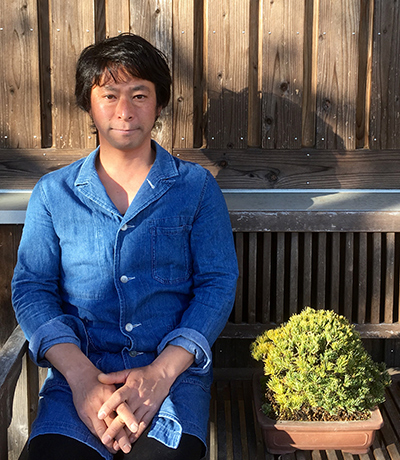 Takahiro Mori
Takahiro Mori
Bonsai master Takahiro Mori was born in Tokyo in 1979. After graduating from the College of Applied International Studies at Tokiwa University, in 2002 he began studying bonsai as an apprentice at Katsuta Koushouen, a bonsai garden in Ibaraki Prefecture. In 2006, he became independent and launched his own activities. In 2009, one of his works won the Kokufu Award at the Kokufu-ten Bonsai Exhibition, an event with a long and distinguished history. From 2009 to 2013, he worked as an in-house bonsai artist at the Omiya Bonsai Art Museum, Saitama. In 2013, he traveled to Kosice in Slovenia, the European Capital of Culture 2013, as a bonsai demonstrator, and participated as a representative of bonsai masters in the presentation for Saitama's bidding to host the 8th World Bonsai Convention, which will be held in 2017. Mori conducted demonstrations at Bonsai Slovakia 2014, and participated as a bonsai expert in the Japan Government exhibit at the EXPO 2016 Antalya International Horticultural Exposition held in Turkey in 2016. Today, in addition to his work as a bonsai master, Mori is actively engaged in initiatives to promote the art of bonsai in Japan and abroad through workshops for beginners that he conducts at his atelier Bonsai Mori established in 2013 and bonsai classes he organizes in California in the United States.
Bonsai Mori website: http://bonsaimori.jp/
Bonsai Mori Facebook: https://www.facebook.com/Bonsaimori/
Related Articles
Keywords
Back Issues
- 2022.7.27 Beyond Disasters - T…
- 2022.6.20 Beyond Disasters - T…
- 2021.6. 7 Contributed Article …
- 2021.4.28 Crossing Borders, En…
- 2021.4.27 Contributed Article …
- 2021.4.20 Contributed Article …
- 2021.3.29 Contributed Article …
- 2020.12.22 Interview with the R…
- 2020.12.21 Interview with the R…
- 2020.11.13 Interview with the R…

